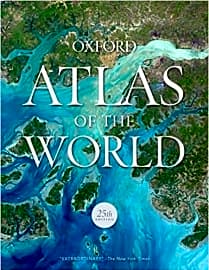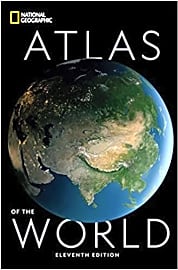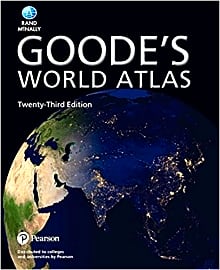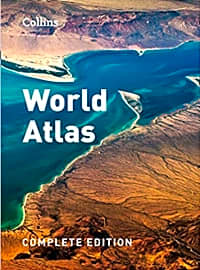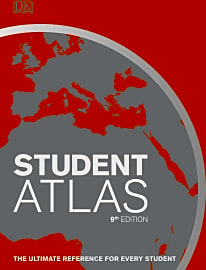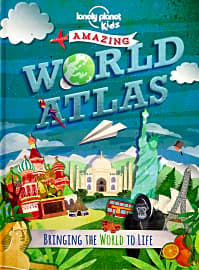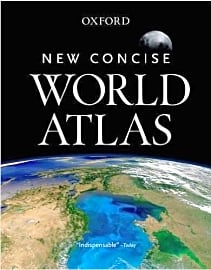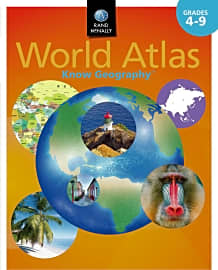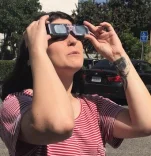The 10 Best World Atlases

This wiki has been updated 40 times since it was first published in March of 2015. Containing information on everything from geography and geopolitics to history and environmental science, one of these world atlases will help broaden your mind and your horizons, without adding more unnecessary screen time to your day. We've included editions suitable for growing children and teenagers through to those detailed and complex enough for any serious scholar. When users buy our independently chosen editorial picks, we may earn commissions to help fund the Wiki.
Editor's Notes
August 12, 2020:
During this round of updates, we ensured every title was in the most current version, which meant bringing the Collins World Atlas and National Geographic Atlas of the World up to their newest editions. Being recent is important for an atlas, however, just how recent it has to be is a matter of personal preference.
For example, we kept the Oxford New Concise World Atlas, despite being published at the end of 2015, due to its impressive range of maps, satellite imagery, an extensive index, and other features. While some statistics or political leanings may have changed, it's still rife with useful information, with another upside being its lowered price. Finally, if you're looking to compare trends over the years, an older atlas can provide helpful insight.
The Lonely Planet Amazing World Atlas is also from several years ago, but since this volume tends to focus on perennial information and history that children will find interesting regardless of when it happened, we felt it was suitable to keep around. For more youngster-friendly choices, consider the Know Geography World Atlas or our full list of atlases for kids.
Young people who want something less childish and more adult will appreciate the newly-added DK Student World Atlas, which we brought on to replace the DK Complete Atlas 3rd Edition. This option is ideal for middle schoolers but can still be helpful for high schoolers and adults, as well as comprehensible to younger children. It provides some solid information but isn't quite as in-depth as the more comprehensive atlases out there, which may be by design so as not to overwhelm young readers.
June 09, 2019:
World atlases are more than just books of maps. Most contain a large amount of information, as well. This may include geopolitical histories, charts and graphs on climate change, cultural facts, studies on human migration, and more. They make a nice change to looking up stuff on the internet, as you know all of the information in the book has been vetted for accuracy. That being said, some atlases do have more of a focus on a visual representation of the world and may contain a large number of high-quality maps and images with less accompanying information. If you are in the market for one of these, we recommend the National Geographic Visual Atlas of the World and Oxford New Concise World Atlas. They make excellent coffee table books and would be ideal for anyone who enjoys studying maps and looking at stunning imagery.
For those in the market for atlases that make excellent reference books, we recommend the The Times Comprehensive Atlas of the World, Oxford Atlas of the World, National Geographic Atlas 10th Edition, Goode's World Atlas 23rd Edition, and DK Complete Atlas 3rd Edition. All of these contain a wealth of information, in addition to maps. Of these, The Times Comprehensive Atlas is probably the most all-encompassing, though the National Geographic Atlas 10th Edition is not far behind.
If you are trying to get your children away from their laptop or phone screen for a little while and interested in learning about the world, the Lonely Planet Amazing World Atlas and Know Geography World Atlas can help. The former should definitely spark a child's interest in travel too, so it makes a great gift right before their first international trip.
Most of the atlases on this list are rather hefty, which is generally desired since this allows for larger maps and images. Of course, there are times when you want a small book that you can keep in a backpack for reference when on the go, which is where the diminutive Collins World Atlas fits in.
Special Honors
World History Atlas Ideal for history buffs, teachers, and students, this app offers a chronological and geographical presentation of historical topics and events. Users can travel through the history of humankind from the earliest civilizations to the present. Access information on a wide variety of categories, including military events, famous figures, natural and astronomical occurrences, technical achievements, disasters, humanities, sport, and religion. history4geeks.com
Earth 3D World Atlas Appropriate for ages four and up, this interactive 3D globe app features wonders of the world, political and physical maps, and global weather. Users can discover an abundance of interesting facts and useful information about the planet via original and colorful graphics, a user-friendly interface, nighttime sky feature, day-to-night cycles, over 2,600 geographic objects, and more. 3planesoft.com
How to Choose the Best World Atlas for You
Before choosing a world atlas, it's important to know ahead of time where your interests mainly lie.
Before choosing a world atlas, it's important to know ahead of time where your interests mainly lie.
Are you more concerned with where things are? Or are you more interested in statistics--in the climatic, economic, religious, and social differences between countries?
Or perhaps you need a world atlas that teaches you how to make maps, or one that fascinates your 10-year-old with beautiful pictures of Mount Fuji and the Leaning Tower of Pisa.
Some world atlases focus heavily on political maps--maps that show borders, the locations of cities, major highways, and bodies of water. Some are littered with info-graphics about air pollution with bright colors highlighting places like Beijing and New Delhi. Others are designed to help kids learn to read with easy-to-understand charts about literacy rates.
Although no two world atlases are the same, they do share a common trait: they aren't exactly cheap. So before dropping lots of money on a weighty tome that might not have all the information you are looking for, or might prove inaccessible to younger family members, don't forget to take a closer look at which is which.
Why is Greenland so Big and Africa so Small?
Many of you may recognize this map as the one that adorned your classroom wall in grade school. Behold, the Mercator projection--the most well-known yet least accurate world map of them all in terms of scale!
But what do you mean, least accurate in terms of scale?
Allow me to explain.
He took the North and South Poles, the smallest circles on the globe, and stretched them out until they were as fat around as the equator.
The world is a ball, not a sphere, but a kind of acne-riddled kickball that caught cooties at an early age. It's covered in scars we call canyons and bumps we call mountains. Now take one of those mountains and stretch it out until it's as big around as your entire face. Fortunately for us, that's not how the world actually works.
But that's what Mercator did. He took the North and South Poles, the smallest circles on the globe, and stretched them out until they were as fat around as the equator.
So now when we look at a map we think Greenland, which is near the North Pole, is almost as big as Africa, which is on and around the equator, even though Africa is almost ten times larger than Greenland.
From Titan to King to Collection
Originally compiled by Italian cartographer Pietro Coppo between 1524 and 1526, the first known collection of equal-sized maps depicting regions of the world remained unpublished despite Coppo's efforts. It was not until 1570 when Abraham Ortelius, a Flemish cartographer, compiled his own collection of maps and successfully published them as Theatrum Orbis Terrarum ("Theater of the World"), thus earning Ortelius the title of creator of the first modern atlas.
After all, if a Greek mythological Titan can carry the world on its shoulders, then why can't a collection of maps do the same?
However, the term "atlas" itself did not enter the modern geographer's lexicon until 1595 when Ortelius' Flemish contemporary, Gerardus Mercator (whose famous Mercator projection can be found in classrooms worldwide), published his own collection of maps in direct competition with Ortelius' Theatrum. He used an image of a globe-holding King Atlas of Mauretania as the frontispiece and named the collection Atlas sive Cosmographicae Meditationes de Fabrica Mundi et Fabricati Figura ("Atlas, or Cosmographical Meditations upon the Creation of the Universe, and the Universe as Created").
According to etymologists, Mercator was the first cartographer to use the name "Atlas" in direct reference to the globe itself, as opposed to the character holding it. Not only that, but he emphasized as much in his choice of frontispiece.
Rather than use the classical image of Atlas carrying the weight of the world on his shoulders, Mercator instead used a commissioned image of King Atlas, a known astronomer, holding a globe in his hands like a book--as if to imply that King Atlas is reading the "atlas" that Mercator compiled. After all, if a Greek mythological Titan can carry the world on its shoulders, then why can't a collection of maps do the same? For Mercator, the collection is the Titan.
And to top it all off, due to the unwieldy length of the collection's original title, readers of the English translation of 1636 dubbed the book simply Atlas, thereby completing the transition from "Atlas," the Greek mythological Titan, to "atlas", a collection of maps.



